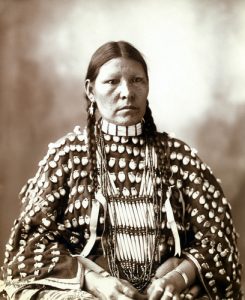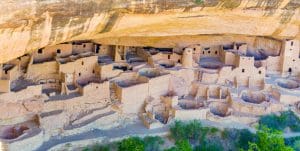 It should be acknowledged that the State of Colorado exists on the traditional lands of the Arapaho, Ute, Cheyenne, Apache, Pueblo and Shoshone people. These people continue to live on this land and are joined by Indigenous People from many other Native nations. Whether they have lived here for thousands of years, were forced to relocate, or have chosen to live here, they have all made countless contributions to the state.
It should be acknowledged that the State of Colorado exists on the traditional lands of the Arapaho, Ute, Cheyenne, Apache, Pueblo and Shoshone people. These people continue to live on this land and are joined by Indigenous People from many other Native nations. Whether they have lived here for thousands of years, were forced to relocate, or have chosen to live here, they have all made countless contributions to the state.
Indigenous Peoples
Arapaho, opens a new window

Around 1000 BCE, the ancestral Arapaho people lived in the Great Lakes region in what is now Manitoba, Canada and Minnesota. As European colonization marched west, the Arapaho and Cheyenne people were forced off their traditional lands and eventually settled on the Great Plains.
They gradually moved south before settling along the Platte and Arkansas Rivers in what is now Colorado, Wyoming, Nebraska and Kansas. This move caused the Arapaho people to abandon their farming lifestyle and they became nomadic people, opens a new window, surviving off buffalo hunting, foraging and trading.
They are traditionally a deeply religious people, opens a new window and often find symbolic meaning in everyday objects and actions. The flat pipe is an especially important object that is kept in a sacred bundle with a hoop or wheel.
The warrior is another major part of Arapaho culture. After they were forced to move west, they became expert horsemen and the warriors were not only highly skilled in combat, but were also expected to keep the peace among the camps, provide food for the people and serve as guards for the camp. They were initially enemies with many of the neighboring tribes but ultimately became allies with them to fight off the invading US soldiers, miners and settlers.
After the Treaty of 1851, the Arapaho and Cheyenne occupied significant portions of Wyoming and Colorado and parts of Kansas and Nebraska. After the Treaty of 1868, the Arapaho were left without a land base and were placed on the Wind River Reservation in Wyoming with the Shoshone people.
Today, the Arapaho and Cheyenne Nations, opens a new window are federally recognized as one tribe but they both maintain their unique culture and traditions. They continue to keep their traditional language, a variation of the Algonquin language, active and are the most southwestern group of people to speak the language.
Cheyenne, opens a new window
Prior to the 1700s, the Cheyenne people lived in what is now Minnesota. They eventually moved to the Plains to hunt bison and to escape the pressure from their enemies and European colonization in the region. By 1730, they had settled in what is now Colorado and Wyoming and split into two bands, the Northern and Southern Cheyenne.
Each band had a Peace Chief who met to discuss and make important decisions. Some bands also had military societies who lead hunts, directed battles and served as disciplinarians. Each society had their own traditions and rituals.
The Hotamétaneo’o or “Dog Warrior Society” was one of the most prominent of these groups. They used a whistle made from the bone of a bird’s wing to signal to each other during battles. They continue to practice their own form of the Sun Dance and celebrate the Animal Dance which is meant to help hunters bring back enough food for everyone.
By the 1830s, the Cheyenne and the Arapaho had become close allies and merged into one Nation. They were widely known for their tanning skills and their hides were used for trading with other Indigenous Nations and European colonizers. One of their main trading locations was in Southeastern Colorado at and around Bent’s Old Fort.
Today, the Cheyenne and Arapaho Tribes Culture Program, opens a new window does community outreach to teach members tribal customs and traditions. They also have a strong belief in teaching their traditional language to new generations. The Cheyenne and Arapahoe Language Program offers classes and, through the Master Apprentice Program, has a goal of three fluent speakers of each language at any given time.
Ute, opens a new window
The Ute people are the oldest residents of what is now the state of Colorado. Before the introduction of the horse to this region, the Ute people lived off the land traveling along well-established routes, many of which can still be seen and traveled today.
During this time, they became skilled at basket weaving and the quill work which adorned much of their clothing. They were accomplished hunters whose tanned hides were a highly desired trade item. Prior to contact with European colonizers, there were several unique bands within the Ute tribe, opens a new window that called Colorado home, including the Weenuchiu, Mouache and White River Ute.
With the arrival of the horse, the Ute were able to hunt larger game like bison more efficiently. Their power and influence began to grow, and they traded horses and goods more widely, ranging as far away as California.
As more European settlers began moving to the area they inevitably came into conflict with the Ute. Most of the Southern Ute people, opens a new window in Colorado were forced onto a reservation just south of Durango and Pagosa Springs.
Today, they work on providing social welfare, educational programs and resources to their members but also have a strong focus on maintaining their traditions. They opened an academy in 2000 that provides day care and education from six months to sixth grade and has a strong focus in teaching the Ute language to students.
Most tribal members live in and around the town of Ignacio, CO. Every spring the Ute Bear Dance is celebrated, an event that is open to the public. In the summer, they participate in their most important spiritual ceremony, the Sun Dance. In the late summer, the annual Southern Ute Tribal Fair and Powwow, opens a new window is held. It is also open to the public and is full of Ute tradition and culture.
Apache, opens a new window
While many Apache bands would sometimes extend into Colorado, only one called parts of Colorado home permanently. These were the Jicarilla Apache, opens a new window, a name given to them by Spanish colonizers meaning “Little Basket”.
They primarily used parts of Southern Colorado for hunting bison, antelope and various smaller game. They often raided the Pueblo people and subsequently incorporated a lot of their ritual and material culture from them. The Jicarilla band was the one most influenced by Pueblo gardening.
After encountering Spanish colonizers, they were in constant conflict with them and their Comanche allies. After decades of war with these two groups, the Jicarilla Apache were forced onto a reservation in 1874 near Dulce, New Mexico where they have primarily lived since.
Their most significant rituals are the Bear Dance, which is used as a curing rite, and a Relay Race. The Race uses the aid of their deities and heroes to help ensure a good food supply. They have been able to maintain a large amount of their traditional religious practices despite much of the forced schooling and indoctrination experienced in the past 150 years.
Ancestral Pueblo, opens a new window
The Ancestral Pueblo people lived in what is now the four corners area where Colorado, Arizona, New Mexico and Utah meet. They lived here from approximately 100-1600 CE before becoming the modern Pueblo Nations. They were often in conflict over resources with neighboring Nations and this history can be seen by the names other Nations have for these people, opens a new window.
Much of what is known of the Ancestral Puebloans comes from archaeological evidence and the histories of their rival Nations. Because of this, trying to label this group of people, opens a new window who lived on a large area of the Southwest is often tricky and unfair to the rich diversity of traditions that have been discovered.
The evidence in Colorado shows that the people living here were skilled pottery and basket makers. The most familiar part of this culture in Colorado is the Mesa Verde Cliff Dwellings, now a National Park. It is believed it was inhabited between 550-1300 CE and was likely abandoned due to climate change. It is believed these people moved South and joined with the Pueblo people along the Rio Grande in New Mexico.
Non-Permanent Nations
Other Indigenous people whose territory sometimes extended into modern day Colorado include the Shoshone, opens a new window, Comanche, opens a new window, Kiowa, opens a new window and Navajo, opens a new window nations.
Prominent Indigenous Coloradans
Linda Hogan, opens a new window (1947 - ) - Chickasaw: Author
Sherman Coolidge, opens a new window (1862 – 1932) – Arapaho: Founder of the Society of American Indians
Chief Niwot, opens a new window (1825 – 1864) – Arapaho: Tribal leader
Chipeta, opens a new window (1843 - 1924) – Born Kiowa Apache, raised by Utes: Indigenous Rights Activist and diplomat
Chief Ouray, opens a new window (1833-1880) – Ute: Tribal leader and diplomat
Mistanta (Owl Woman), opens a new window (? - 1847) – Cheyenne: Diplomat
Ben Nighthorse Campbell, opens a new window (1933 - ) – Cheyenne: U.S. Senator from Colorado
Resources to Explore Further
Northern Arapaho Tribe official website, opens a new window
Cheyenne and Arapahoe Tribes official website, opens a new window
Southern Ute Tribe official website, opens a new window
Jicarilla Apache Nation official website, opens a new window
Encyclopedia of Native Tribes of North America
Encyclopedia of American Indian History & Culture
Blog post created by Cody R.




Add a comment to: Indigenous Colorado